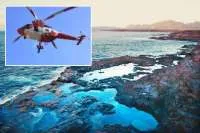Two earthquakes detected in the Canary Islands in the last 24 hours
- 12-10-2024
- National
- Canarian Weekly
- Photo Credit: IGN
The National Geographic Institute (IGN) has reported two earthquakes in the Canary Islands in the last few hours. A 3.0 magnitude earthquake was recorded on the island of El Hierro, while a smaller 1.7 magnitude tremor occurred in the waters between Tenerife and Gran Canaria.
The first quake, with a magnitude of 3.0 mbLg, took place at 7:12pm last night, Friday, October 11th, at a depth of 19 kilometres, west of El Pinar in El Hierro. This area is known for its seismic activity, though no damage has been reported from this event.
The second tremor, with a magnitude of 1.7 mbLg, occurred early this morning (Saturday) at 5:04am It was located 25 kilometres below the seabed in the channel between Tenerife and Gran Canaria.
Both earthquakes were relatively deep, with no significant impacts reported on land. However, the occurrence of seismic activity continues to be closely monitored in the region, which lies on a tectonically active zone.
Seismic activity in the Canary Islands
Seismic activity in the Canary Islands is driven by the region's unique geological and volcanic context, as the islands are part of an active volcanic archipelago. Seismic activity is primarily related to volcanic processes, although tectonic forces also play a role.
Key Factors Influencing Seismic Activity in the Canary Islands
1. Volcanic Origin: The Canary Islands were formed by volcanic activity, with each island representing a different stage of volcanic development. The islands are situated over a hotspot, a plume of hot material rising from deep within the Earth’s mantle. This hotspot leads to the generation of magma, which causes volcanic eruptions and, at times, seismic events.
2. Types of Seismic Events:
o Volcano-tectonic earthquakes: These earthquakes are associated with magma movement beneath the Earth's surface. As magma rises toward the surface, it fractures the surrounding rock, causing earthquakes. These tend to be shallow and localised around active volcanic areas.
o Tectonic earthquakes: Though volcanic processes dominate, the Canary Islands are also influenced by regional tectonic stresses. These are typically deeper and can be related to the movements of the African Plate and the nearby Mid-Atlantic Ridge.
3. Recent Seismic Activity: The islands periodically experience increased seismic activity, especially around volcanic eruptions or periods of magma movement. The most prominent recent example is the 2021 volcanic eruption of Cumbre Vieja on La Palma, where seismic swarms (clusters of earthquakes) preceded and accompanied the eruption. Seismic swarms are often seen as precursors to volcanic eruptions because they indicate magma movement within the Earth's crust.
4. Seismic Swarms: Before volcanic eruptions, such as the 2021 eruption on La Palma, the region can experience seismic swarms, with hundreds or thousands of small earthquakes occurring in a short time frame. These quakes reflect the stress changes and magma migration beneath the surface. During the La Palma eruption, the seismic activity was intense, with some earthquakes reaching magnitudes above 4.0.
5. Volcanic Hazard: Some islands in the archipelago, such as Tenerife, La Palma, and El Hierro, are more seismically active due to their volcanic history. El Hierro, for example, experienced intense seismic activity in 2011, leading to an underwater volcanic eruption off the coast.



























































